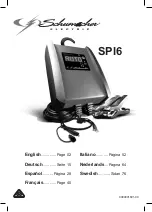
Catalog #17934
Brochure #63-0224
Page 4 of 5
©2004 Edelbrock Corporation
Rev. 2/04 - RS/mc
PUMP INSTALLATION
•
Note:
Your pump may be mounted in one of two ways,
if mounted as shown in Fig. 2, read “Type A Installation”
below. If mounted as shown in Fig. 3, continue to “Type
B Installation further down.
TYPE A INSTALLATION
1. Using petroleum jelly, sparingly lubricate the fuel outlet
tube on the bracket and the pump outlet fitting. Using
the appropriate hose (of the three supplied in the kit) for
your application, cut the hose to the proper length
needed (use your stock hose as a guide if necessary).
2. Place the supplied fuel pump isolator (thin) over the
pump.
3. Slip the rubber fuel hose and both hose clamps onto the
fuel outlet fitting on the pump and fit the pump on the
bracket. Rotate the pump as needed to obtain the best
pump outlet fitting to bracket outlet tube alignment.
4. Slip the rubber hose over the bracket outlet tube. Make
sure the hose is still fully seated against the pump.
Position and tighten the hose clamps.
5. Using one of the supplied cable ties, secure the pump to
the bracket.
TYPE B INSTALLATION
1. Using petroleum jelly, sparingly lubricate the fuel outlet
tube on the bracket and the pump outlet fitting. Using
the appropriate hose (of the three supplied in the kit) for
your application, cut the hose to the proper length
needed (use your stock hose as a guide if necessary).
2. Place the fuel hose and one hose clamp over the pump
outlet fitting. Slip the supplied fuel pump isolator (thick)
on the pump. Fit the pump into the carrier using the
stock mounting o-ring (if equipped), rubber inlet spacer
and inlet o-ring. Rotate the pump as required to achieve
best pump outlet fitting to bracket outlet tube
alignment.
3. Firmly seat the pump/carrier assembly into the filter
adapter. Reinstall any stock pump mounting hardware.
4. Reattach the pump/carrier assembly to the bracket.
5. Slip the rubber hose over the bracket outlet tube. Make
sure the hose is still fully seated against the pump.
Position and tighten the hose clamps.
PUMP INSTALLATION (Continuation)
1. Connect the electrical connections using the supplied
wire harness and butt splice connectors, making sure
proper polarity is maintained.
2. Install the proper fuel filter for your application. Type A
units press onto the bottom of the fuel pump. Type B
units attach to the fuel pump filter adapter using the
supplied fuel filter seal. Make sure the filter is
positioned in the same manner as the original filter.
BRACKET INSTALLATION
1. Inspect the fuel tank for dirt and debris. If the amount
of dirt or debris is excessive, clean the fuel tank before
installing the bracket assembly.
2. Inspect the bracket to make sure it is clean and ready
for installation.
3. Use the supplied o-ring seal and place it in the groove
at the fuel tank opening.
4. Insert the bracket being careful not to damage the fuel
filter. Tighten the locking ring or bolts to secure the
bracket to the fuel tank.
FUEL TANK INSTALLATION
1. Inspect the condition and location of all tank mounting
pads, insulators and brackets. Defective, missing or
mislocated pads and insulators will cause the
transmission of excessive noise into the vehicle.
2. Inspect and correct any defects in the fuel hoses, filler
neck connections, or similar components related to the
fuel system.
3. Install the fuel tank in the vehicle and tighten the tanks
support strap bolts. Reconnect the filler neck if it was
removed. Reconnect all lines and hoses and tighten
securely. Connect the electrical connections. Make
certain that all hoses, fittings, and electrical
connections are correctly and securely attached.
4. Be sure that all fuel lines are correctly routed and
secured in any mounting brackets. Make sure the
wiring harness is installed in the original position and
secured in any wire clips or brackets, if present.























